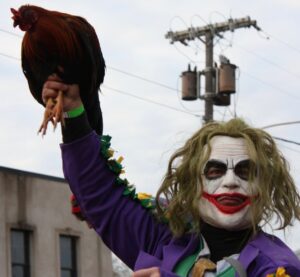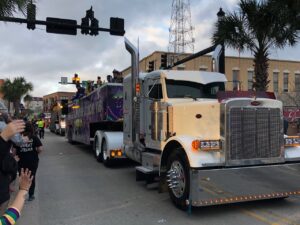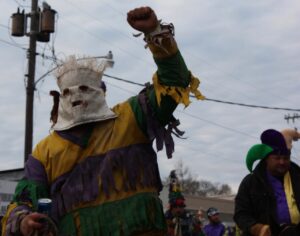
People outside Louisiana think of Mardi Gras as a New Orleans celebration, but those in the state who live outside New Orleans do not think of it much and have their own traditions.
Louisiana Travel, a state booster site, breaks down Mardi Gras celebrations into regions: Greater New Orleans, Northshore [of Lake Pontchartrain], Plantation Country [includes Baton Rouge, the capital], Cajun Country (most of the coast), Crossroads (Alexandria, in mid-state), and North Louisiana (Ruston and Monroe).
You can expect to find many of the same things in all these places—food, local music, costumes, and parades with people throwing beads, candy, and little toys to crowds. But there are some differences that make it interesting to move around and sample local events.
In a city like Lake Charles, which has 200,000 residents in its bigger metropolitan area, Mardi Gras is a professionalized, civic event. There are a dozen parades over several days, including a lighted-boat parade on the lakefront; a series of Twelfth Night events, such as a car show and seniors’ dance; a gumbo cook-off; a children’s day; a Mardi Gras Madness 5K; a zydeco dance; and a Royal Gala, for which krewe “courts” dress up in their gown-and-sequin finery and perambulate the Civic Center floor to be judged in the spotlights.

Parades in Lake Charles are all family-friendly; the big Krewe of Krewe’s parade is just a bigger version of the Children’s Parade. The parades are on an industrial scale, too, fitting a petrochemical town, with many of the “floats” pulled by semis. Some are what you might think of as elaborate floats, such as full-sized pirate ships on tractor-trailer bases. But here they often refer to “trailer parades,” since the floats are more like live-bottom trailers, or oil tankers cut in half, with riders standing in them. Beads, most of them cheap and identical, are the most-thrown item, but you have to stay alert. Moon Pies hurt.
The more rural the celebration, the more tied it is to its landscape and to the past. Yesterday morning I headed over to Iowa (Eye-uh-way), Louisiana, for the 38th annual Chicken Run. Iowa is a town of 3,000, to the east of Lake Charles, on the way to Lafayette. Participants were almost exclusively African-American. The parade started at the KC Hall, a pole-barn on the edge of town, and was a mix of lawn-care trailers loaded with porta-potties, barbecue grills, and passengers; expensive Honda and Polaris four-wheelers with swamp tires; and a couple of dozen horses with riders in boots and cowboy hats. A priest said benediction and reminded everyone of safety-first, for the children’s sake.

The parade headed down a state road into the countryside. At designated houses dancers got down to zydeco, and homeowners offered up things for the gumbo. The parade stopped at the Market Basket supermarket, the VF Factory Outlet, and eventually, Rabideaux’s Sausage Kitchen. At some of these places the “captain” of the parade threw a live chicken out for kids to chase. Later, the chickens, now filled with terror hormones, were added to the gumbo pot.
A couple of years ago, we went in search of what people here call “the old Mardi Gras” or “the real Mardi Gras.” Deeper into the countryside, in places like Mamou, the chicken run is called by its older name, a Courir de Mardi Gras, and the captain is the capitaine. The medieval-rooted costumes become more primitive-looking and even frightening, with overtones of Klan and ghillie suit. (Costumes are also often ingenious folk art. One specialty is Crown Royal bags, chosen for their color, sewn together into jackets.)

Horses are not as well-bred or -groomed and do not wear expensive rigs. They get ridden hard, all day, and end up muddy and slick with sweat, and their eyes roll in panic at the smaller parade-crowds. The (mostly) men who ride them are often falling-out-of-the-saddle drunk on Michelob Ultra. Race and politics enter in, with rubber masks of Obama and Hillary Clinton. But these celebrations have the whiff of authenticity, something not performed for tourists—or elsewhere in the country.
